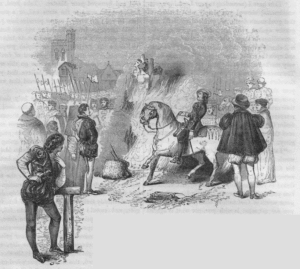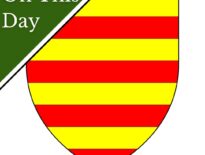 On this day in Tudor history, 27th January 1556, in the reign of Queen Mary I, Protestant Bartlet or Bartholomew Green was burnt at the stake at Smithfield, with six other Protestants.
On this day in Tudor history, 27th January 1556, in the reign of Queen Mary I, Protestant Bartlet or Bartholomew Green was burnt at the stake at Smithfield, with six other Protestants.
Green, who martyrologist John Foxe describes as a gentleman and lawyer, “saw the true light of God’s gospel” when listening to lectures given by Peter the Martyr while studying at Oxford. Foxe writes that “Whereof when he had once tasted, it became unto him as the fountain of lively water, that our Saviour Christ spake of to the woman of Samaria, so as he never thirsted any more, but had a well springing unto everlasting life”. Green studied law at the Inner Temple at London.
At Easter 1554, Green received communion according to the Protestant rites of the late King Edward VI’s reign at the home of John Pullain, rector of St Peter Cornhill, with his friend, Christopher Goodman, who was just about to leave England to go into exile. He did it a second time with Michael Renniger, and continued celebrating this way and refusing to attend the Catholic mass or confession. As his biographer, Thomas S. Freeman, points out, he might have got away with this if it hadn’t been for the fact that he appears to have been behind the circulation of a bill in 1555 which was smuggled into London from the Continent. It denounced Philip of Spain and Mary I, and supported Elizabeth. Also, in a letter to his friend, Goodman, he reported “the queen is not yet dead”, which could be twisted to be treasonous.
Green was apprehended and imprisoned in the Fleet and then in the Tower of London and when a charge of treason could not stand up, he was questioned on matter concerning religion. In his confession, he confessed to not attending mass, and receiving both the bread and wine. He denied the real presence in the Eucharist, saying that he “received material bread and material wine, no substance thereof changed, and so no real presence of the body and blood of Christ there being, but only grace added thereto”. This was heresy.
While he was examined by Edmund Bonner, Bishop of London, he was held at the bishop’s palace, sharing a room with John Dee and being treated well, so well, in fact, that it was rumoured that he’d recanted. He didn’t recant, though, not even when his grandfather tried to bribe him with a large amount of money. On 15th January 1556, after an examination by Bishop Bonner and John Feckenham, Abbot of Westminster, Green was found guilty of heresy and condemned to death. He was taken to Newgate to await his death. There, he was visited by friends including William Fleetwood and Thomas Hussey.
On 27th January 1556, he was taken to Smithfield with priest Thomas Whittle, artificers John Tudson and John Went, Thomas Browne, Isabel Foster and Joan Warne or Lashford. Merchant tailor and diarist Henry Machyn recorded that “they were all burned by nine at 3 posts; and there were a commandment through London overnight that no young folk should come there, for there the greatest number was as has been seen at such a time.” Foxe writes of how they were burnt on one fire and that they “went most cheerfully unto the place of their torments, often repeating, as well by the way, as also at the stake, these verses following:
O Christ, my God, sure hope of health, besides thee have I none:
The truth I love, and falsehood hate, be thou my Guide alone.”
And that was the end of Barlet or Bartholomew Green.
Image: Engraving of the burning of Bartlet Green and six other martyrs from John Foxe's Actes and Monuments



Thomas Whittle is my ancestor